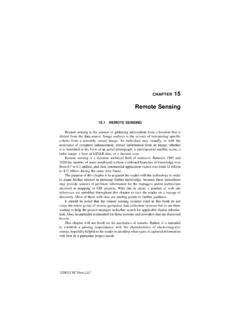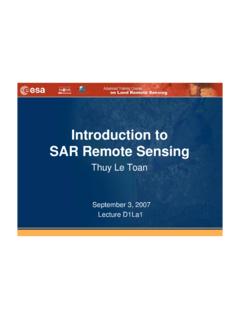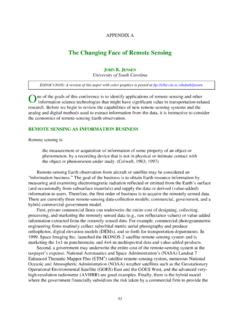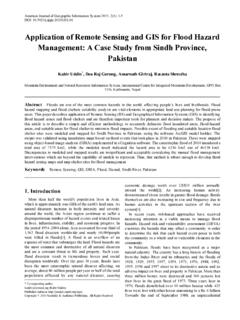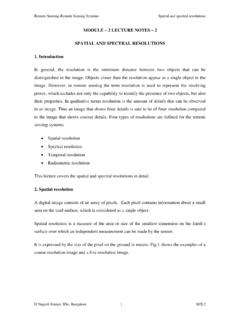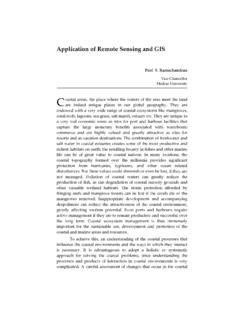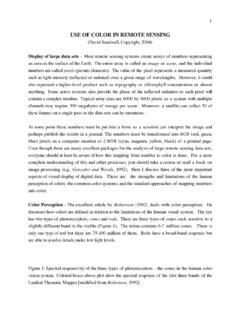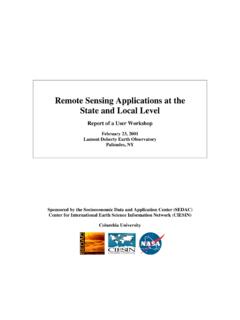Transcription of Introduction to RADAR Remote Sensing for …
1 Introduction to RADAR Remote Sensing for vegetation mapping and MonitoringWayne Walker, What is RADAR (and what does it measure)? RADAR as an active sensor Applications of RADAR to vegetation mapping / monitoring What determines RADAR backscatter from vegetation ? System parameters (Sensor) Target parameters (Ground) What is Speckle? Photographic review of forest structureOutlineWhat is RADAR ? RADAR is an acronym that stands for:Radio Detection and RangingRADIOWhat is RADAR ? RADAR is an acronym that stands for:Radio Detection and Ranging Runningtime: Distance: t=2Rc2ctR=What is RADAR ?SAR is an acronym that stands for:SyntheticApertureRADARAll imaging RADAR sensors used for Remote Sensing are SyntheticApertureRadars.
2 Phased Array L-Band SARA. Roth, MFFU Sommerschule, 2000 Amplitude depends on target properties (structure and dielectric properties). Phase is a function of the distance between sensor and the target as well as target does RADAR measure?Passive sensors: Rely on the sun as an energy source Detect only naturally occurring energy Energy SourcePassive sensorRADAR as an active sensorEnergy SourceActive sensorActive sensors: Act as their own energy source Detect backscattered energy Applications mapping forest/land cover mapping wetlands (inundated/flooded versus non-flooded) mapping structural attributes (height, basal area, biomass, volume) monitoring disturbance (logging, fire, windthrow, insect damage) monitoring change (deforestation, degradation, reforestation) monitoring photosynthetic processes (growing-season length)Applications of RADAR to vegetation mapping / monitoring System Parameters (Sensor) Wavelength/Frequency (X, C, L, and P bands) Polarization (HH, VV, and HV) Incidence angle Resolution Target Parameters (Ground)
3 Structure (size, orientation, and distribution of scattering surfaces) Surface roughness (relative to wavelength) Dielectric constant (moisture content) Slope angle/orientationWhat determines RADAR backscatter from vegetation ? System Parameters (Sensor) Wavelength/Frequency (X, C, L, and P bands) Polarization (HH, VV, and HV) Incidence angle ResolutionWhat determines RADAR backscatter from vegetation ?Scattering from vegetationTypes of scattering from a pine standWavelength/FrequencyWavelength/Freq uency The primary scatterers in a tree canopy are elements (leaves, branches, and stems) with a size on the order of the wavelength or larger and an orientation similar to that of the incoming signal polarization.
4 Elements smaller than the wavelength produce little backscatter but can attenuate the signalC-band (5 cm)L-band (23 cm)P-band (30-100 cm)The longer the wavelength, the greater the sensitivity to the vertical structure of vegetationX-band (3 cm)Wavelength/FrequencyWavelength/Freque ncyPolarizationSource: J. R. Jensen. 2000. Remote Sensing of the WaveLong WaveCTTCT CT CC = CrownT = TrunkDepolarization occurs mainly over vegetation , hardly over open ground. Cross polarization (HV or VH) is very sensitive to vegetation parametersNo DepolarizationCourtesy of T. LeToanPolarizationLittle DepolarizationDepolarizationMultiple ScatteringPolarizationHH, VV, HV and color composite of linear polarization images of agricultural fields in southern Manitoba ( CCRS 1993).
5 Acquired by the CV-580 C-band SAR. Processed and provided by angle50 m15 mSensitivity to Type BoundariesResolution50 m15 mResolutionSensitivity to Type Boundaries50 m15 mResolutionSensitivity to Individual Trees System Parameters (Sensor) Wavelength/Frequency (X, C, L, and P bands) Polarization (HH, VV, and HV) Incidence angle Resolution Target Parameters (Ground) Structure (size, orientation, and distribution of scattering surfaces) Surface roughness (relative to wavelength) Dielectric constant (moisture content) Slope angle/orientationWhat determines RADAR backscatter from vegetation ? Target Parameters (Ground) Structure (size, orientation, and distribution of scattering surfaces) Surface roughness (relative to wavelength) Dielectric constant (moisture content) Slope angle/orientationWhat determines RADAR backscatter from vegetation ?
6 StructureConifer -ExcurrentBroadleaf -DecurrentTaperDead snagStructureSurface roughness As wavelength increases, greater height variation is required for roughness As incidence angle increases, greater height variation is required for roughnessDielectric constant (moisture content) Dielectric constant is controlled by the amount of moisture content Most common materials have dielectric constants from 1-100 RADAR backscatter is influenced by the amount of moisture in vegetation and soil by affecting the absorption and propagation of electromagnetic energy Increasing the moisture content reduces the penetration of the RADAR signal through a vegetation canopy or into r ia D ielect r ic constant V acuum 1 (by d A ir P aper 3.)
7 5 P y re x glas 4 .7 W ater (20 ) Differentvegetationtypeswillallhavediffe rentbackscatterproperties. Inaddition,thebasicreflectivityofthesoil ,calledthe"dielectricconstant" a strongreflector. constant (moisture content)Dielectric constant (moisture content)Slope angle/orientationWhat is speckle?Speckle filtering always results in a loss of spatial resolution since it is carried out within moving windows. What is speckle?Original dataFrost filterGamma MAP filterRetford, UK ERS-2 SAR data April-September 1998 Speckle filtering always results in a loss of spatial resolution since it is carried out within moving windows.
8 What is speckle?Structure at the individual tree levelStructure at the individual tree levelStructure at the landscape level (natural landscapes)Structure at the landscape level (disturbed landscapes)Structure at the landscape level (managed landscapes)Structure at the landscape level (ice/snow)Structure at the landscape level (fire)Structure at the landscape level (moisture influences)Thank you!

